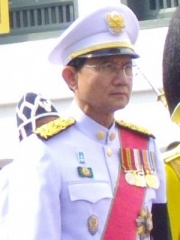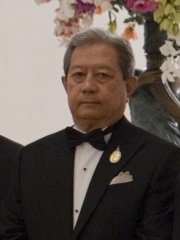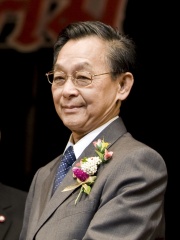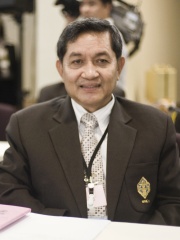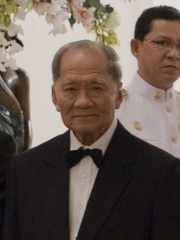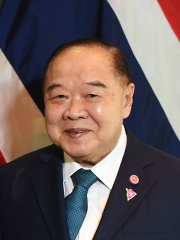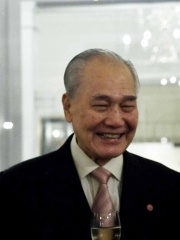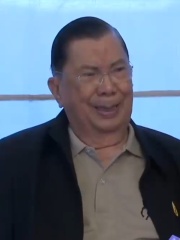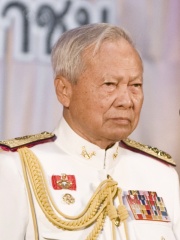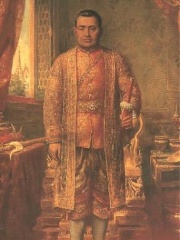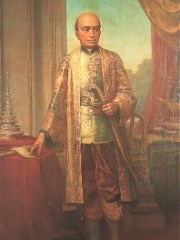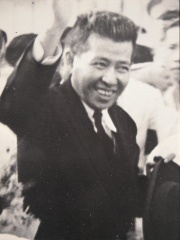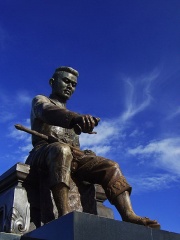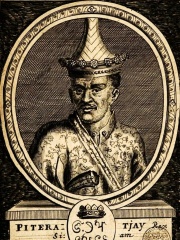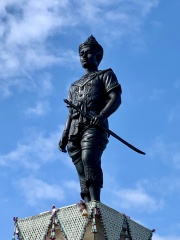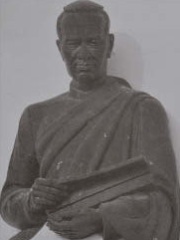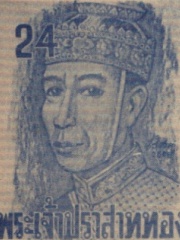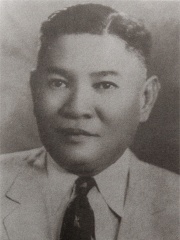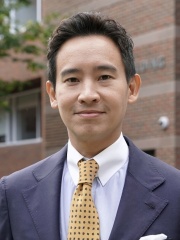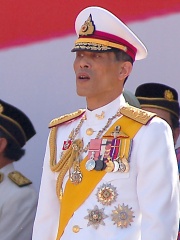
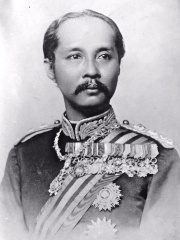
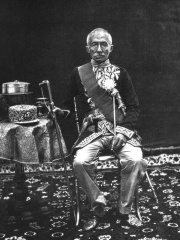
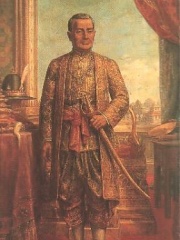
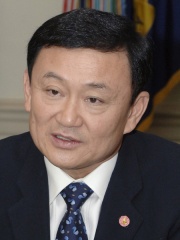
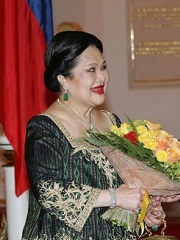
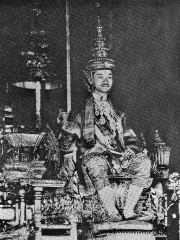
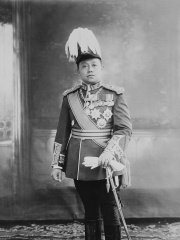
The Most Famous
POLITICIANS from Thailand
This page contains a list of the greatest Thai Politicians. The pantheon dataset contains 19,576 Politicians, 57 of which were born in Thailand. This makes Thailand the birth place of the 51st most number of Politicians behind Slovakia, and Lithuania.
Top 10
The following people are considered by Pantheon to be the top 10 most legendary Thai Politicians of all time. This list of famous Thai Politicians is sorted by HPI (Historical Popularity Index), a metric that aggregates information on a biography’s online popularity. Visit the rankings page to view the entire list of Thai Politicians.

1. Vajiralongkorn (b. 1952)
With an HPI of 70.83, Vajiralongkorn is the most famous Thai Politician. His biography has been translated into 94 different languages on wikipedia.
Vajiralongkorn (born 28 July 1952) is King of Thailand. He is the tenth monarch of Thailand from the Chakri dynasty, styled as Rama X. The only son of King Bhumibol Adulyadej and Queen Sirikit, he was made crown prince by his father in 1972, at the age of 20. After his father's death on 13 October 2016, he was expected to ascend to the throne of Thailand but asked for time to mourn before taking the throne. He accepted the throne on the night of 1 December 2016. His coronation took place from 4–6 May 2019. The Thai government retroactively declared his reign to have begun on 13 October 2016, upon his father's death. Aged 64 at that time, Vajiralongkorn became the oldest Thai monarch to ascend to the throne. He is the wealthiest monarch in the world, with a net worth estimated to be between US$30 billion and US$70 billion.

2. Chulalongkorn (1853 - 1910)
With an HPI of 69.31, Chulalongkorn is the 2nd most famous Thai Politician. His biography has been translated into 60 different languages.
Chulalongkorn (Thai: จุฬาลงกรณ์, 20 September 1853 – 23 October 1910) was the fifth monarch of Siam under the House of Chakri, titled Rama V from 1 October 1868 to his death in 23 October 1910. Chulalongkorn was born as the son of King Mongkut in 1853. In 1868, he travelled with his father and Westerners invited by Mongkut to observe the solar eclipse of 18 August 1868 in Prachuap Khiri Khan Province. However, Chulalongkorn and his father both contracted malaria which resulted in his father's death.Chulalongkorn's reign was characterised by the modernisation of Siam, governmental and social reforms, and territorial concessions to the British and French. As Siam was surrounded by European colonies, Chulalongkorn, through his policies and acts, ensured the independence of Siam. All his reforms were dedicated to ensuring Siam's independence given the increasing encroachment of Western powers, so that Chulalongkorn earned the epithet Phra Piya Maharat (พระปิยมหาราช, the Great Beloved King).

3. Mongkut (1804 - 1868)
With an HPI of 67.31, Mongkut is the 3rd most famous Thai Politician. His biography has been translated into 50 different languages.
Mongkut (Thai: มงกุฏ; 18 October 1804 – 1 October 1868) was the fourth king of Siam under the House of Chakri, titled Rama IV. He ruled from 1851 to 1868. His full title in Thai was Phra Poramenthra Ramathibodhi Srisindra Maha Mongkut Phra Chomklao Chao Yu Hua Phra Sayam Thewa Maha Makut Witthaya Maharat (พระบาทสมเด็จพระปรเมนทรรามาธิบดีศรีสินทรมหามงกุฎ พระจอมเกล้าเจ้าอยู่หัว พระสยามเทวมหามกุฏวิทยมหาราช).King Mongkut of Siam, also known as Rama IV, left a lasting imprint on popular culture through various adaptations of the story "Anna and the King of Siam." This narrative, inspired by Anna Leonowens' memoir, vividly captures her encounters and experiences within the Siamese court during King Mongkut's reign from 1862 to 1867. Among these adaptations, the 1951 musical "The King and I" and its 1956 film adaptation stand out as iconic representations. These works introduced audiences worldwide to the character of King Mongkut, offering a dramatized portrayal of his dynamic interactions with Anna Leonowens and the cultural complexities of Siam during that era. Despite his international recognition primarily through these adaptations, King Mongkut's legacy extends far beyond the realm of entertainment. His reign was marked by significant modernization initiatives and diplomatic engagements, which played pivotal roles in shaping Thailand's trajectory towards progress and international relations. Siam first felt the pressure of Western expansionism during Mongkut's reign. Mongkut embraced Western innovations and initiated the modernization of his country, both in technology and culture—earning him the nickname "The Father of Science and Technology" in Siam. Mongkut was also known for appointing his younger brother, Prince Chutamani, as Second King, crowned in 1851 as King Pinklao. Mongkut told the country that Pinklao should be respected with equal honor to himself (as King Naresuan had done with his brother Ekathotsarot in 1583). During Mongkut's reign, the power of the House of Bunnag reached its zenith: It became the most powerful noble family of Siam.

4. Rama I (1736 - 1809)
With an HPI of 66.53, Rama I is the 4th most famous Thai Politician. His biography has been translated into 50 different languages.
Phra Bat Somdet Phra Phutthayotfa Chulalok Maharat (Thai: พระบาทสมเด็จพระพุทธยอดฟ้าจุฬาโลกมหาราช, 20 March 1737 – 7 September 1809), personal name Thongduang (ทองด้วง), also known as Rama I, was the founder of the Rattanakosin Kingdom and the first monarch of the reigning Chakri dynasty of Siam (now Thailand). His full title in Thai is Phra Bat Somdet Phra Paramoruracha Mahachakkriborommanat Phra Phutthayotfa Chulalok (พระบาทสมเด็จพระปรโมรุราชามหาจักรีบรมนารถ พระพุทธยอดฟ้าจุฬาโลก). He ascended the throne in 1782, following the deposition of King Taksin of Thonburi. He was also celebrated as the founder of Rattanakosin (now Bangkok) as the new capital of the reunited kingdom. Rama I, whose given name was Thongduang, was born from a Mon male line descent family, great-grandson of Kosa Pan. His father served in the royal court of the Ayutthaya Kingdom. Thongduang and his younger brother Boonma served King Taksin in wars against the Burmese Konbaung dynasty and helped him in the reunification of Siam. During this time he emerged as Siam's most powerful military leader. Thongduang was the first Somdet Chao Phraya, the highest rank the nobility could attain, equaled to that of royalty. In 1782, he took control of Siam and crowned himself as the monarch. The most famous event in his reign was the Burmese–Siamese War of 1785–86, which was the last major Burmese assault on Siam. Rama I's reign marked a revival of Siamese culture and state organization following the collapse of the Siamese kingdom in 1767, whose capital was then situated at Ayutthaya. He established a new purified Buddhist sect which allied and tied together Buddhism and the monarchy. Rama I consolidated and expanded on Taksin's military campaigns throughout Mainland Southeast Asia, whose mandala in 1809 stretched as far North and South as the Shan States and the Northern Malay Peninsula and as far East as the Annamite Range, respectively. His reign also marked the beginning of a new "Golden Age of Culture", which continued in the footsteps of the blossoming of the arts during the Late Ayutthaya Period.
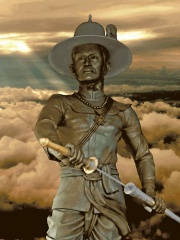
5. Taksin (1734 - 1782)
With an HPI of 65.25, Taksin is the 5th most famous Thai Politician. His biography has been translated into 43 different languages.
King Taksin the Great (Thai: สมเด็จพระเจ้าตากสินมหาราช, RTGS: Somdet Phra Chao Taksin Maharat, ) or the King of Thonburi (Thai: สมเด็จพระเจ้ากรุงธนบุรี, RTGS: Somdet Phra Chao Krung Thon Buri; simplified Chinese: 郑昭; traditional Chinese: 鄭昭; pinyin: Zhèng Zhāo; Teochew: Dên Chao; 17 April 1734 – 7 April 1782) was the only king of the Thonburi Kingdom that ruled Thailand from 1767 to 1782. He had been an aristocrat in the Ayutthaya Kingdom and then was a major leader during the liberation of Siam from Burmese occupation after the Second Fall of Ayutthaya in 1767, and the subsequent unification of Siam after it fell under various warlords. He established the city of Thonburi as the new capital, as the city of Ayutthaya had been almost completely destroyed by the invaders. His reign was characterized by numerous wars; he fought to repel new Burmese invasions and to subjugate the northern Thai kingdom of Lanna, the Laotian principalities, and a threatening Cambodia. Although warfare occupied most of Taksin's reign, he paid a great deal of attention to politics, administration, economy, and the welfare of the country. He promoted trade and fostered relations with foreign countries. He had roads built and canals dug. Apart from restoring and renovating temples, the king attempted to revive literature, and various branches of the arts such as drama, painting, architecture and handicrafts. He also issued regulations for the collection and arrangement of various texts to promote education and religious studies. He was taken in a coup d'état and executed, and succeeded by his long-time friend Maha Ksatriyaseuk, who then assumed the throne, founding the Rattanakosin Kingdom and the Chakri dynasty, which has since ruled Thailand. In recognition for his deeds, he was later awarded the title of Maharaj (The Great).

6. Thaksin Shinawatra (b. 1949)
With an HPI of 65.11, Thaksin Shinawatra is the 6th most famous Thai Politician. His biography has been translated into 67 different languages.
Thaksin Shinawatra (born 26 July 1949) is a Thai businessman and politician. He served in the Thai Police from 1973 to 1987, and was the Prime Minister of Thailand from 2001 to 2006. Thaksin founded the mobile phone operator Advanced Info Service and the IT and telecommunications conglomerate Shin Corporation in 1987, ultimately making him one of the richest people in Thailand. He founded the Thai Rak Thai Party (TRT) in 1998 and, after a landslide electoral victory, became prime minister in 2001. He was the first democratically elected prime minister of Thailand to serve a full term and was re-elected in 2005 by an overwhelming majority.Thaksin declared a "war on drugs" in which more than 2,500 people were killed. Thaksin's government launched programs to reduce poverty, expand infrastructure, promote small and medium-sized enterprises, and extend universal healthcare coverage. Thaksin took a strong-arm approach against the separatist insurgency in the Muslim southern provinces.His decision to sell shares in his corporation for more than a billion tax-free dollars generated controversy. A citizens' movement against Thaksin, called People's Alliance for Democracy or "Yellow Shirts", launched mass protests, accusing him of corruption, abuse of power, and autocratic tendencies. In 2006 Thaksin called snap elections that were boycotted by the opposition and invalidated by the Constitutional Court. Thaksin was deposed in a military coup on 19 September 2006. His party was outlawed and he was barred from political activity. Thaksin lived in self-imposed exile for 15 years—except for a brief visit to Thailand in 2008—before returning to Thailand in August 2023. During his exile he was sentenced in absentia to two years in jail for abuse of power, and stripped of his Police Rank of Police Lieutenant Colonel.From abroad, he continued to influence Thai politics through the People's Power Party that ruled in 2008 and its successor organisation Pheu Thai Party, as well as the United Front for Democracy Against Dictatorship or "Red Shirt" movement. His younger sister Yingluck Shinawatra was the prime minister of Thailand from 2011 to 2014. Later in exile, Thaksin registered a Clubhouse account under the name Tony Woodsome, which became his moniker, and frequently held activities on the platform. He also made several announcements expressing his desire to return to Thailand on various social media platforms. Ultimately, Thaksin returned to Thailand on 22 August 2023, and was promptly taken into custody.

7. Sirikit (b. 1932)
With an HPI of 65.04, Sirikit is the 7th most famous Thai Politician. Her biography has been translated into 42 different languages.
Sirikit (born Mom Rajawongse Sirikit Kitiyakara; 12 August 1932) is a member of the Thai royal family who was Queen of Thailand from 28 April 1950 to 13 October 2016 as the wife of King Bhumibol (Rama IX) and mother of King Vajiralongkorn (Rama X). She met Bhumibol in Paris, where her father was Thai ambassador. They married in 1950, shortly before Bhumibol's coronation. Sirikit was appointed queen regent in 1956, when the king entered the Buddhist monkhood for a period of time. Sirikit has one son and three daughters with the king. Consort of the monarch who was, at the time the world's longest-reigning head of state, she was also the world's longest-serving queen consort. Sirikit suffered a stroke in 2012 and has since refrained from public appearances.

8. Prajadhipok (1893 - 1941)
With an HPI of 64.71, Prajadhipok is the 8th most famous Thai Politician. His biography has been translated into 46 different languages.
Prajadhipok (Thai: ประชาธิปก, RTGS: Prachathipok, 8 November 1893 – 30 May 1941), also Rama VII, was the seventh monarch of Siam of the Chakri dynasty. His reign was a turbulent time for Siam due to political and social changes during the Revolution of 1932. He is to date the only Siamese monarch of the Chakri dynasty to abdicate.

9. Vajiravudh (1880 - 1925)
With an HPI of 64.54, Vajiravudh is the 9th most famous Thai Politician. His biography has been translated into 47 different languages.
Vajiravudh (Thai: วชิราวุธ, RTGS: Wachirawut, 1 January 1881 – 26 November 1925) was the sixth monarch of Siam under the Chakri dynasty as Rama VI. He ruled from 23 October 1910 until his death in 1925. King Vajiravudh is best known for his efforts to create and promote Siamese nationalism. His reign was characterized by Siam's movement further towards democracy and minimal participation in World War I. He had keen interests in Siamese history, archaeology, and literature, as well as economics, politics and world affairs, and founded the country's first university, Chulalongkorn University.
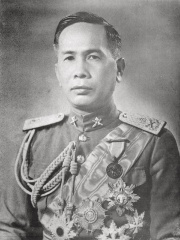
10. Plaek Phibunsongkhram (1897 - 1964)
With an HPI of 64.23, Plaek Phibunsongkhram is the 10th most famous Thai Politician. His biography has been translated into 46 different languages.
Field Marshal Plaek Phibunsongkhram (Thai: แปลก พิบูลสงคราม [plɛ̀ːk pʰí.būːn.sǒŋ.kʰrāːm]; alternatively transcribed as Pibulsongkram or Pibulsonggram; 14 July 1897 – 11 June 1964), locally known as Marshal P. (Thai: จอมพล ป.;[tɕɔ̄ːm.pʰōn.pɔ̄ː]), and contemporarily known as Phibun (Pibul) in the West, was a Thai military officer and politician who served as Prime Minister of Thailand from 1938 to 1944 and 1948 to 1957. Phibunsongkhram was a member of the Army wing of Khana Ratsadon, the first political party in Thailand, and a leader of the Siamese revolution of 1932, which replaced Thailand's absolute monarchy with a constitutional monarchy. Phibun became the third Prime Minister of Thailand in 1938 while serving as Commander of the Royal Siamese Army. Inspired by the Italian fascism of Benito Mussolini, he established a de facto military dictatorship run along fascist lines, promoted Thai nationalism and Sinophobia, and allied Thailand with Imperial Japan in World War II. Phibun launched a modernization campaign known as the Thai Cultural Revolution that included a series of cultural mandates, which changed the country's name from "Siam" to "Thailand", and promoted the Thai language. Phibun was ousted as prime minister by the National Assembly in 1944 and replaced by members of the Free Thai Movement, but returned to power after the Siamese coup d'état of 1947, led by the Coup Group. Phibun aligned Thailand with anti-communism in the Cold War, entered the Korean War under the United Nations Command, and abandoned fascism for a façade of democracy. Phibun's second term as prime minister was plagued by political instability and several attempts to launch a coup d'etat against him were made, including the Army General Staff plot in 1948, the Palace Rebellion in 1949, and the Manhattan Rebellion in 1951. Phibun attempted to transform Thailand into an electoral democracy from the mid-1950s onward, but was overthrown in 1957 and went into exile in Japan, where he died in 1964. At fifteen years and one month, Phibun's term as Prime Minister of Thailand was the longest to date.
People
Pantheon has 64 people classified as Thai politicians born between 1188 and 2005. Of these 64, 24 (37.50%) of them are still alive today. The most famous living Thai politicians include Vajiralongkorn, Thaksin Shinawatra, and Sirikit. The most famous deceased Thai politicians include Chulalongkorn, Mongkut, and Rama I. As of April 2024, 7 new Thai politicians have been added to Pantheon including Phetracha, Mangrai, and Borommatrailokkanat.
Living Thai Politicians
Go to all RankingsVajiralongkorn
1952 - Present
HPI: 70.83
Thaksin Shinawatra
1949 - Present
HPI: 65.11
Sirikit
1932 - Present
HPI: 65.04
Prayut Chan-o-cha
1954 - Present
HPI: 60.14
Somchai Wongsawat
1947 - Present
HPI: 55.82
Surayud Chulanont
1943 - Present
HPI: 55.14
Chuan Leekpai
1938 - Present
HPI: 53.60
Sonthi Boonyaratglin
1946 - Present
HPI: 53.33
Thanin Kraivichien
1927 - Present
HPI: 52.32
Prawit Wongsuwon
1945 - Present
HPI: 52.11
Anand Panyarachun
1932 - Present
HPI: 51.26
Chavalit Yongchaiyudh
1932 - Present
HPI: 51.19
Deceased Thai Politicians
Go to all RankingsChulalongkorn
1853 - 1910
HPI: 69.31
Mongkut
1804 - 1868
HPI: 67.31
Rama I
1736 - 1809
HPI: 66.53
Taksin
1734 - 1782
HPI: 65.25
Prajadhipok
1893 - 1941
HPI: 64.71
Vajiravudh
1880 - 1925
HPI: 64.54
Plaek Phibunsongkhram
1897 - 1964
HPI: 64.23
Prem Tinsulanonda
1920 - 2019
HPI: 62.44
Rama III
1788 - 1851
HPI: 61.76
Rama II of Siam
1767 - 1824
HPI: 61.45
Pridi Banomyong
1900 - 1983
HPI: 60.39
Naresuan
1555 - 1605
HPI: 60.10
Newly Added Thai Politicians (2024)
Go to all RankingsPhetracha
1632 - 1703
HPI: 55.33
Mangrai
1238 - 1311
HPI: 53.31
Borommatrailokkanat
1431 - 1488
HPI: 52.16
Prasat Thong
1599 - Present
HPI: 52.11
Prawit Wongsuwon
1945 - Present
HPI: 52.11
Thawi Bunyaket
1904 - 1971
HPI: 43.95
Pita Limjaroenrat
1980 - Present
HPI: 43.10
Overlapping Lives
Which Politicians were alive at the same time? This visualization shows the lifespans of the 25 most globally memorable Politicians since 1700.


